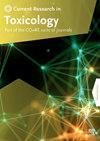蒽醌染料茜素红S的遗传毒性试验。
IF 2.9
Q2 TOXICOLOGY
引用次数: 0
摘要
蒽醌染料茜素红S (ARS)用于标记活体动物,特别是作为监测濒危欧洲鳗鱼种群的工具,在将捕获的鳗鱼放归野外之前,用ARS标记捕获的鱼类。由于即使在数年后仍可在重新捕获的鳗鱼中发现ARS,因此了解ARS的潜在健康危害对于评估标记有ARS的鳗鱼的食品安全至关重要。由于蒽醌类化合物具有遗传毒性和致癌性,因此对标记鳗鱼的食品安全提出了关注。到目前为止,还没有描述急性呼吸道感染潜在危害的数据。在这项研究中,我们旨在缩小这一数据差距。我们在肝细胞(HepG2)、宫颈细胞(HeLa)和淋巴母细胞(TK-6)中检测了ARS,发现HepG2细胞是对ARS诱导的细胞毒性最敏感的细胞系。然后,我们研究了这些细胞中的氧化应激、DNA链断裂和微核形成,并没有观察到亚细胞毒性浓度的影响。本文章由计算机程序翻译,如有差异,请以英文原文为准。
Genotoxicity testing of the anthraquinone dye Alizarin Red S
The anthraquinone dye Alizarin Red S (ARS) is used for marking live animals, specifically as a tool for monitoring the stock of the endangered European eel by marking caught fish with ARS before releasing the eels back into the wild. As ARS can be found in recaptured eels even years later, knowledge of potential health hazards of ARS is essential for assessing the food safety of eels marked with ARS. As the compound class of anthraquinones is known for their genotoxic and carcinogenic properties, concerns were raised regarding the food safety of marked eels. Up to now, no data for characterizing the hazard potential of ARS is available. In this study, we aimed at closing this data gap. We tested ARS in liver (HepG2), cervix (HeLa) and lymphoblast (TK-6) cells and identified HepG2 cells as the cell line most sensitive to ARS-induced cytotoxicity. We then investigated oxidative stress, DNA strand breaks, and micronucleus formation in these cells and did not observe effects at sub-cytotoxic concentrations.
求助全文
通过发布文献求助,成功后即可免费获取论文全文。
去求助
来源期刊

Current Research in Toxicology
Environmental Science-Health, Toxicology and Mutagenesis
CiteScore
4.70
自引率
3.00%
发文量
33
审稿时长
82 days
 求助内容:
求助内容: 应助结果提醒方式:
应助结果提醒方式:


